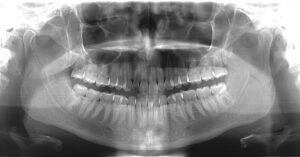Header logo
header top contact widget
Learn More Blog
What Can A Periodontist Do For You?
Posted on May 13, 2024 by William J. Claiborne, DDS MS
In meeting someone for the first time, a common question is “What do you do?” Telling them that I am a periodontist often gets followed by another question: “What does a periodontist do?” The long version, according to the American Academy of Periodontology, is:
“A periodontist is a dentist who specializes in the prevention, diagnosis, and treatment of periodontal disease, and in the placement of dental implants. Periodontists are also experts in the treatment of oral inflammation. Periodontists receive extensive training in these areas, including three additional years of education beyond dental school. They are familiar with the latest techniques for diagnosing and treating periodontal disease, and are also trained in performing cosmetic periodontal procedures.”
Choosing this dental specialty is achieved by an understanding that it will require many years of education. A periodontist begins by completing 4 years of college (undergraduate training) followed by another 4 years in dental school to earn a doctorate. The periodontal specialty then requires another 3-4 years before completing the stringent requirements for a specialty certification in periodontics.
What can all of this in-depth education and advanced skill level do for you?
Let’s begin with the diagnosis and treatment of all stages of periodontal (gum) disease. According to the Centers of Disease Control & Prevention (CDC), it is estimated that over 47% of Americans have some level of gum disease, which is also the leading cause of tooth loss. That’s nearly half of our population.
In addition to a healthy smile, the health of your gums can impact your overall health. By keeping the bacteria of advanced gum disease, known as periodontitis, you lower your risks of a long list of serious health problems that have been shown connected to gum disease bacteria. These include heart disease, stroke, diabetes, arthritis, Alzheimer’s disease, some cancers, preterm babies, and erectile dysfunction (ED).
A periodontal specialist is also a leading choice in the selection and placement of dental implants. With specialized skills, a periodontist is especially respectful to oral tissues as sensitive layers that have an important role in the appearance of a smile and the health of teeth. Utilizing these skills, a periodontist can help to minimize incisions while effectively treating each area in the mouth.
When it comes to the selection of the implant system best for you, our speciality also understands the complete spectrum of all implant types. Some implant systems offer a non-removable (“fixed”) option with others functioning with removable teeth.
Proper selection of your dental implants can also help to keep treatment fees to a minimum. This is because some implants can support more than one tooth and others are designed to support a full arch of replacement teeth. Because treatment fees are based on the number of implants required, your tooth replacement goals may be within a more manageable budget with fewer implants needed to accomplish your goals.
Reshaping gum tissues is also part of our specialized skills. The gum tissues are designed to provide a tight seal around the base of teeth and block bacterial entry to the sensitive tooth root area. When oral bacteria are able to penetrate beneath the gum line, they can cause inflammation to tender gums and attack the structures that support natural teeth.
In a procedure known as a gingivectomy, we are able to reposition or graft gum tissues over the area of recession to restore a healthy seal and protect the tooth structures below the surface.
In some cases, we are also able to save a natural tooth when the tooth breaks near the gum line. In a procedure known as crown lengthening, a periodontist can sometimes expose enough of the tooth structure for the placement of a crown. By preventing the need for the tooth’s removal, the patient is able to avoid the extensive costs and potential upkeep of replacing it.
When it comes to a smile’s appearance, a periodontist is also the go-to. In smiles that have an uneven line of gum tissues, meaning that some teeth have more gum showing than others. This up-and-down line of gum tissue creates a jumbled look. Crown lengthening can alter the height of these tissues prior to placement of a crown (‘cap’) to provide a more flattering smile line.
Another benefit of the skills of gum recontouring are the correction of a “gummy smile.” In this, the patient has too much gum tissue bordering the tops of teeth, making the smile line unbalanced. Using the gingivectomy procedure, a periodontist can lower the height of gum tissues, which is generally followed by placement of crowns.
Here, our Western North Carolina periodontal dental office features some of the most advanced technology in dentistry. Many of these features are not available in other dental offices elsewhere. Some of these include:
LANAP With PerioLase MVP 7 (Laser-Assisted New Attachment Procedure) – an advanced protocol that efficiently and effectively treats advanced gum disease with the added advantages of a dental laser. This offers a non-surgical alternative for patients with moderate to severe periodontal disease. LANAP treatment has also been found to stimulate bone regrowth in damaged areas.
3-D Cone Beam Imaging – used for diagnoses and treatment planning, giving clear views of the upper and lower jaw, used for intricate review of sagittal, axial, and coronal planes, locating and tracking nerve canals optimizes implant placement.
CareStream Cone Beam Computer Tomography Imaging – provides enhanced tomography that interacts with 3D imaging for exceptional detail and range.
CS 3600 Intraoral Scanner – This scanner quickly and comfortably captures digital impressions without the need for bulky, goopy trays! Through this process, we are able to create precision models or appliances (crowns, inlays, onlays, bridges, orthodontic appliances and aligners, custom abutments). The scanner can also reach difficult–to–access areas in the patient’s mouth for superior results with improved patient comfort.
Computerized Dental Implant Placement – allows for pre-surgical positioning of dental implants using a 3D model of the patient’s jaw. Once the implant type is selected, a template is developed for optimal treatment success, even for complex cases.
Sedation Dentistry – When dental fear or anxiety causes people to delay or avoid having dental treatment, we offer oral or IV sedation. Oral sedation is a pill that helps patients relax. It also has an amnesiac effect, leaving most with little or no memory of treatment afterward. I.V. sedation (also known as “twilight sleep”) places the patient in a deeper sleep state and erases memory of the procedure.
Through our extensive menu of treatments offered, it’s easy to see that our main goal is to provide patients with a comfortable and positive experience within our specialized skills. We believe this helps patients truly appreciate the advantages of a healthy smile and understand how our involvement can create a healthier, more confident individual.
I also feel it’s important that people are aware of the signs and symptoms of periodontal disease, which are:
• Red, swollen or tender gums
• Seeing blood in the sink when brushing
• Receded gums
• Loose or separating teeth
• Pus pockets on gum tissues
• Sores in the mouth
• Persistent bad breath
If any of these are present, please know that the condition will only worsen without treatment. And, early treatment can minimize treatment needs and costs.
Call 828-274-9440 if you have questions or wish to arrange a consultation discuss your individual needs (or those of a smile you love!). Our Asheville periodontal dental office staff will be happy to help you!
Recent Posts
Categories
Archives
- September 2024
- August 2024
- July 2024
- June 2024
- May 2024
- April 2024
- March 2024
- February 2024
- January 2024
- December 2023
- November 2023
- October 2023
- September 2023
- August 2023
- July 2023
- June 2023
- May 2023
- April 2023
- March 2023
- February 2023
- January 2023
- December 2022
- November 2022
- October 2022
- September 2022
- August 2022
- July 2022
- June 2022
- May 2022
- April 2022
- March 2022
- February 2022
- January 2022
- December 2021
- November 2021
- October 2021
- September 2021
- August 2021
- July 2021
- June 2021
- May 2021
- April 2021
- March 2021
- February 2021
- January 2021
- December 2020
- November 2020
- October 2020
- September 2020
- August 2020
- July 2020
- June 2020
- May 2020
- April 2020
- March 2020
- February 2020
- January 2020
- December 2019
- November 2019
- October 2019
- September 2019
- August 2019
- July 2019
- June 2019
- May 2019
- April 2019
- March 2019
- February 2019
- January 2019
- December 2018
- November 2018
- October 2018
- September 2018
- August 2018
- July 2018
- June 2018
- May 2018
- April 2018
- March 2018
- February 2018
- January 2018
- December 2017
- November 2017
- October 2017
- September 2017
- August 2017
- July 2017
- June 2017
- May 2017
- April 2017
- March 2017
- February 2017
- January 2017
- December 2016
- November 2016
- October 2016
- September 2016
- August 2016
- July 2016
- June 2016
- May 2016
- April 2016
- March 2016
- February 2016
- January 2016
- December 2015
- November 2015
- October 2015
- September 2015
- August 2015
- July 2015
- June 2015
- May 2015
- April 2015
- March 2015
- February 2015
- January 2015
- December 2014
- November 2014
- October 2014
- September 2014
- August 2014
- July 2014
- June 2014
- May 2014
- April 2014
- March 2014
- February 2014
- January 2014
- December 2013
- November 2013
- October 2013
- September 2013
- August 2013
- July 2013
- June 2013
- May 2013
- April 2013
- March 2013
- February 2013
- January 2013
- December 2012
- November 2012
- October 2012
- September 2012
- August 2012
- July 2012
- June 2012

